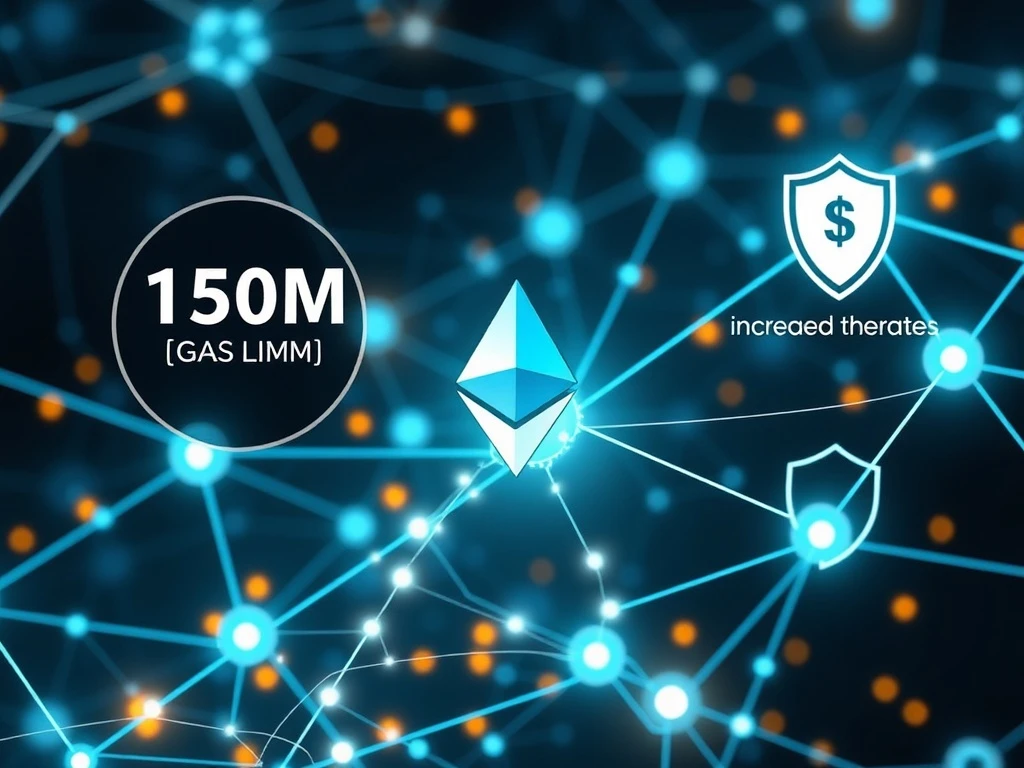Ethereum Fusaka Fork: A Monumental Leap for Scalability and Security in 2025

Are you ready for the next monumental shift in the Ethereum ecosystem? Get ready, because the highly anticipated Ethereum Fusaka Fork is on the horizon, slated for early November 2025. This isn’t just another incremental update; it’s a strategic move designed to significantly bolster the network’s foundational capabilities, particularly in terms of scalability and security. While recent upgrades like Pectra focused on user-facing enhancements, Fusaka dives deep into the backend, promising a more robust and efficient blockchain for everyone.
Understanding the Ethereum Fusaka Fork: A Backend Revolution
The Ethereum Fusaka Fork represents a critical phase in Ethereum’s ongoing evolution. Unlike previous upgrades that might have introduced flashy new features for users, Fusaka is all about refining the core engine of the blockchain. It’s a collection of 11 Ethereum Improvement Proposals (EIPs) that work in concert to optimize fundamental parameters and strengthen network resilience. Think of it as a massive engine overhaul, making the system run smoother and more powerfully under the hood.
- Focus on Core Parameters: Fusaka is not about new user interfaces or dApp functionalities. It’s about adjusting the underlying rules that govern how transactions are processed and blocks are validated.
- Bundling EIPs: This fork bundles multiple EIPs, ensuring a comprehensive set of improvements are deployed simultaneously, creating a synergistic effect on network performance.
- Strategic Timing: The November 2025 activation is strategically aligned with the Devconnect developer conference in Buenos Aires, emphasizing the community’s commitment to continuous, timely development.
Unlocking Ethereum Scalability with a Higher Gas Limit
One of the most impactful changes arriving with Fusaka is the significant increase in the block Ethereum Gas Limit. The limit will be raised to an impressive 150 million units. But what does this mean for you and the network?
Gas is the unit of computational effort required to execute operations on the Ethereum blockchain. Every transaction, every smart contract interaction, consumes gas. By increasing the block gas limit, Ethereum can now process more transactions within each block. This is a direct boost to Ethereum Scalability, addressing one of the network’s long-standing challenges.
Benefits of a 150M Gas Limit:
- More Transactions Per Block: A higher limit means more space for transactions, reducing the backlog during periods of high network activity.
- Potentially Lower Transaction Fees: When block space is abundant, the competition for that space decreases, which can lead to lower gas prices and, consequently, reduced transaction fees for users. This is particularly crucial for decentralized finance (DeFi) and gaming applications where frequent interactions can accumulate significant costs.
- Enhanced Network Throughput: Overall, the network can handle a greater volume of operations, making Ethereum more efficient and responsive.
While the benefits are clear, developers have carefully considered the trade-offs. An increased gas limit can lead to larger blocks, which might slightly increase block propagation times and storage demands on nodes. However, these are deemed manageable within Ethereum’s current infrastructure and ongoing optimizations.
Fortifying Ethereum’s Security: Defending Against Spam Attacks
Beyond scalability, Fusaka also brings crucial enhancements to network security, particularly through the implementation of EIP-7825. This EIP is designed to fortify nodes against spam attacks, a persistent threat to any blockchain network. Spam attacks can clog the network, making it slow and expensive to use, or even temporarily unavailable.
EIP-7825 aims to make it harder and more costly for malicious actors to flood the network with low-value or malicious transactions. By implementing smarter mechanisms for validating and prioritizing transactions, Fusaka helps ensure that legitimate transactions can always get through, even under duress. This commitment to robust security is vital for maintaining user trust and the integrity of the entire ecosystem.
Navigating the Ethereum Upgrade Timeline: Precision and Progress
The deployment of this Ethereum Upgrade is a meticulously planned process, reflecting Ethereum’s mature development cycle. The timeline for Fusaka demonstrates a commitment to thorough testing and synchronized activation:
- July 2025: Devnet launch – The initial testing environment for developers to experiment with the new EIPs.
- September and October 2025: Public Testnets – Broader testing across various client teams and community members, simulating real-world conditions.
- August 1, 2025: Final EIP bundle confirmed – Providing client teams ample time (two months) to integrate the updates into their software.
- Early November 2025: Mainnet Activation – The upgrade will go live at a pre-announced block height, ensuring all nodes update simultaneously.
This accelerated six-month upgrade cadence, a pattern established after the Pectra fork, highlights Ethereum’s agility and determination to continuously improve. Community stakeholders, including Ethereum protocol lead Nixo, have emphasized the importance of adhering to this schedule, especially to align the upgrade with the Devconnect developer conference, fostering momentum and collaboration within the developer community.
The Broader Impact of Fusaka on ETH News and the Competitive Landscape
While Fusaka might lack the immediate user-facing pizzazz of some past upgrades, its impact on the broader ETH News and Ethereum’s competitive standing is profound. By significantly expanding transaction capacity and reinforcing security measures, the fork strengthens Ethereum’s appeal for a wide range of decentralized applications.
Consider the flourishing sectors of decentralized finance (DeFi), blockchain gaming, and NFTs. All these rely heavily on a network that is fast, affordable, and secure. Fusaka directly addresses these needs:
- Attracting DeFi: Lower transaction fees and higher throughput make complex DeFi operations more economically viable for users, encouraging more activity and innovation on Ethereum.
- Boosting Gaming: Blockchain games often involve numerous small transactions. Reduced fees and increased capacity will make the gaming experience smoother and more accessible.
- Retaining Market Dominance: In a landscape increasingly populated by faster Layer 2 solutions and alternative Layer 1 blockchains, maintaining low fees, speed, and robust security is paramount for Ethereum to retain its position as the leading smart contract platform.
Analysts agree that these backend optimizations are crucial for long-term growth and competitiveness. Fusaka ensures Ethereum remains a viable and attractive platform for developers and users alike, solidifying its future trajectory.
Challenges and Ethereum’s Iterative Development Strategy
Ethereum’s development approach is characterized by iterative progress and a cautious balance between innovation and stability. The Fusaka fork exemplifies this strategy. For instance, the decision to exclude EIP-7907, which would have doubled the contract code size limit, was a calculated move.
Initially proposed, EIP-7907 was deferred to a future fork to avoid potential delays in the testing timeline for Fusaka. This highlights a pragmatic approach: prioritizing timely deployment and protocol stability over bundling too many complex changes into a single upgrade. Developers are acutely aware of the potential trade-offs, such as slower block propagation and higher storage demands that come with an increased gas limit, but they consider these manageable within the current infrastructure and are continually working on solutions.
This rigorous testing and thoughtful deferral of complex EIPs underscore Ethereum’s commitment to minimizing risks and ensuring a smooth, secure transition for the entire network. It’s a testament to the project’s dedication to refining the protocol to meet growing demand while preserving decentralization and security principles.
Conclusion: A Milestone for Ethereum’s Future
As the November 2025 activation date for the Ethereum Fusaka Fork draws near, the Ethereum community remains steadfast in its focus on minimizing risks and maximizing efficiency. This upgrade, though primarily backend-focused, marks another significant milestone in Ethereum’s ongoing evolution. By strategically enhancing scalability through an increased gas limit and fortifying security against spam attacks, Fusaka reinforces Ethereum’s foundation, ensuring the network remains adaptable, competitive, and robust enough to meet the challenges and demands of the future decentralized world. It’s a powerful step forward, cementing Ethereum’s position as a leader in the blockchain space.
Frequently Asked Questions (FAQs)
Q1: What is the Ethereum Fusaka Fork?
The Ethereum Fusaka Fork is an upcoming hard fork scheduled for early November 2025. It’s a strategic upgrade focused on backend technical optimizations to enhance Ethereum’s scalability and security, primarily through increasing the block gas limit and implementing new spam defense mechanisms.
Q2: When is the Fusaka Fork expected to go live?
The Fusaka Fork is planned for early November 2025. Testing began in July 2025 with devnet launches, followed by public testnets in September and October 2025, leading up to the mainnet activation at a pre-announced block height.
Q3: What is the significance of the 150 million gas limit?
The increase of the block gas limit to 150 million units is a major boost to Ethereum’s scalability. It allows more transactions and smart contract operations to be processed within each block, potentially leading to lower transaction fees during high demand and overall higher network throughput.
Q4: How does Fusaka improve Ethereum’s security?
Fusaka enhances security primarily through EIP-7825, which aims to fortify nodes against spam attacks. This measure makes it more difficult and costly for malicious actors to flood the network, ensuring greater stability and availability for legitimate transactions.
Q5: Will the Fusaka Fork introduce new user-facing features?
No, unlike some previous upgrades (like the Pectra fork), the Fusaka Fork is primarily focused on backend adjustments and technical optimizations. It bundles 11 Ethereum Improvement Proposals (EIPs) that refine core parameters and bolster network resilience, rather than introducing new features for end-users.
Q6: Was EIP-7907 included in the Fusaka Fork?
No, EIP-7907, which proposed to double the contract code size limit, was intentionally excluded from the Fusaka Fork. Developers opted to defer this change to a future fork to avoid potential delays in the testing timeline and ensure the timely deployment of Fusaka before the Devconnect conference.










